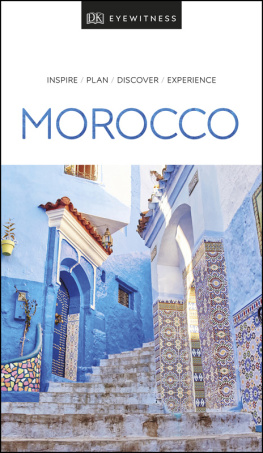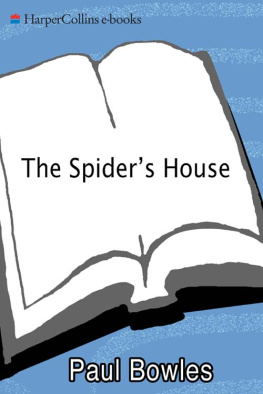Paul Bowles
Journey Through Morocco
Among Paul Bowles' numerous travel writings is "Journey Through Morocco", first published in the February 1963 issue of Holiday magazine. (The original title was "The Route to Tassemsit".) Bowles begins his adventure by car in Tangier, driving through Chaouen, Marrakech, across the Middle, Grand and Anti-Atlas mountains, to Taroudant, Tiznit and Tafraout. He finally arrives at a remote village where he is entertained by musicians and dancers, while recording Moroccan music for the Library of Congress.
Whenever I leave Tangier to go south, my home takes on the look of a place struck by disaster. The night before I set out on this trip the usual disorder prevailed. There were crates of canned foodstuffs and bundles of blankets and pillows in the living room. The portable butane-gas stove and boxes of recording tape covered the road maps.
I said good-by to my servants, who had induced me to write down the things they hoped I would buy for them while I was down there. Fatima wanted a white woolen blanket at least eight meters long, and Mina a silver-plated circular tray with three detachable legs. Following tradition, they had scrupulously insisted that these things were to be paid for out of their wages after I returned, and I had agreed, although each of us was aware that such deductions would never be made. Moroccan etiquette demands that when the master of the house goes on a journey he bring back souvenirs for everyone. The farther he goes and the longer he stays, the more substantial these gifts are expected to be.
In this country departure is often a predawn activity. After the half hour of early-morning prayer calling is finished and the muezzins have extinguished the lights at the tops of the minarets, there is still about an hour of dark left. The choir of roosters trails on in the air above the rooftops of the city until daybreak. It is a good moment to leave, just as the sky is growing white in the east and objects are black and sharp against it. By the time the sun was up, we were far out in the country, rolling along at a speed determined only by the curves and the occasional livestock in the road. The empty highway, visible far ahead, measured off the miles of open, mountainous countryside, and along the way no billboards came between us and the land.
During the past year I had traveled some 25,000 miles around Morocco, recording music for the Library of Congress. The tapes that interested me most were the ones I had recorded in Tafraout, a region in the western Anti-Atlas. Since I had managed to get only six selections there, I wanted to go back there now and try to find some more. By my inland itinerary there was a distance of 855 miles to be covered between Tangier and Tafraout, and the roads would be fairly good all the way. The direct route to Marrakech via Rabat traverses flat terrain and has a certain amount of traffic. The unfrequented interior route we used, which leads through the western foothills of the Rif Mountains and over the Middle Atlas, takes an extra day but is beautiful at every point.
Beyond Xauen [Chaouen] we followed for a while the River Loukkos, here a clear swift stream at the bottom of a narrow valley. We stopped for lunch, my driver and I, spread a rug under an old olive tree and ate, listening to the water skipping over the stones beside us. The hills rose steeply on both sides of the river. Not a person or a dwelling in sight. We started out again.
A half hour farther, we rounded a corner and came upon a man lying face down on the paved surface of the road, his djellaba covering his head. Immediately I thought: "He's dead." We stopped, got out, prodded him a bit, and he sat up, rubbing his eyes, mumbling, annoyed at being awakened. He explained that the smooth road was a better place to sleep than the stony ground beside it. When we objected that he might easily be killed, he replied with the fine peasant logic that no one had killed him yet. Nevertheless, he got up and walked a few yards off the highway, where he slumped down again all in one motion, wrapped the hood of his djellaba around his head, and went back into the comfortable world of sleep.
The next day was hotter. We climbed along the slowly rising ramp of the Middle Atlas, the great range that lies between the Rif and the Grand Atlas, a gray, glistening landscape. The shiny leaves of the scrub live-oaks, and even the exposed bedrock beneath, reflected the hot light of the overhead sun. Farther along, on the southern slope of the mountains, we passed the mangled body of a large ape that had not got out of the road fast enough an unusual sight here, since these animals generally stay far from the highways.
All afternoon we had been speeding down the gradually descending valley between the Middle Atlas and the Grand Atlas. The sun went down ahead of us and the moon rose behind us. We drank coffee from the vacuum bottle and hoped we would get into Marrakech in time to find some food. The new Moroccan regime has brought early closing hours to a land where heretofore night was merely a continuation of day.
After the lunar brightness of the empty wasteland, the oasis was dark. The highway went for miles between high mud walls and canebrakes; the black tracery of date palms rose above them, against the brilliant night sky. Suddenly the walls and the oasis came to an end, and ahead, standing in the rubble of the desert, was a big new cinema trimmed with tubes of colored neon, the tin and straw shacks of a squatters' colony clustering around it like the cottages of a village around the church. In Morocco the very poor live neither in the country nor in the city; they come as far as the outer walls of the town, build there these desparate-looking bidonvilles out of whatever materials they can find, and there they stay.
Marrakech is a city of great distances, flat as a table. When the wind blows, the pink dust of the plain sweeps into the sky, obscuring the sun, and the whole city, painted with a wash made of the pink earth on which it rests, glows red in the cataclysmic light. At night, from a car window, it looks not unlike one of our Western cities: long miles of street lights stretching in straight lines across the plain. Only by day you see that most of these lights illumine nothing more than empty reaches of palm garden and desert.
Over the years, the outer fringes of the Medina have been made navigable to automobiles and horse-drawn buggies, of which there are still a great many, but it takes a brave man to drive his car into the maze of serpentine alleys full of porters, bicycles, carts, donkeys and pedestrians. Besides, the only way to see anything in the Medina is to walk. In order to be really present, you must have your feet in the dust, and be aware of the hot dusty smell of the mud walls beside your face.
The night we arrived in Marrakech, we went to a caf in the heart of the Medina. On the roof under the stars they spread matting, blankets and cushions for us, and we sat there drinking mint tea, savoring the cool air that begins to stir above the city after midnight when the stored heat of the sun is finally dissipated.
Abruptly out of the silence of the street below, there came a succession of strange, explosive cries. I leaned over the edge and peered into the dim passageway three floors beneath. Among the few late strollers an impossible, phantomlike figure was dancing. It galloped, it stopped, it made great gravitation-defying leaps into the air as if the earth under its feet were helping. At each leap it yelled. No one paid any attention. As the figure came below the caf, I was able to identify it as a powerfully built young man; he was almost naked. I watched him disappear into the dark. Almost immediately he returned, doing the same inspired dance, occasionally rushing savagely toward other pedestrians, but always stopping in time to avoid touching them.










